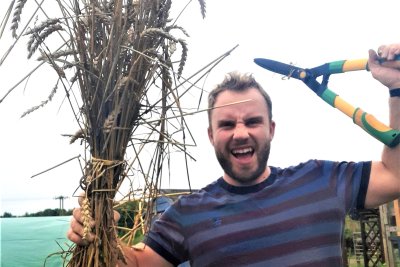Sustain / Real Bread Campaign / Articles
Home grown loaf
In 2020, home baker Oliver Rubinstein also became an amateur cereal grower.

I’m a lifelong Real Bread devotee and, having worked in the agricultural sector for the last decade, am passionate about food production. Despite squeezing every square centimetre of productive space out of my allotment and garden, however, I had always regarded cereal growing as something out of reach to anyone without a tractor.
As for most people, cereal production had seemed fundamentally abstract and inaccessible. For eight months of the year the fields look just like grass. There are no cute lambs or calves to look at, no colourful vegetables to pick. To grow and process cereals you need specialist machinery, which is far beyond most people. Unlike growing vegetables, it doesn’t seem like something you can just start doing for yourself.
Grow, mill, bake
Then something happened to me two years ago that ultimately changed my relationship with baking and grains. Enter the Field to Loaf team. In the summer of 2020, I saw that my friend and former colleague Helen Holmes was running a course at Waterland Organics, just outside Cambridge, with fellow grain enthusiasts Mahala Le May and Nick Fradgley. The aims of the day were to introduce everyone to the basics of cereal growing in low-input systems and to bake some incredible loaves. Most interestingly for me though, was that we learned how to grow, harvest and process cereal crops by hand. This was something it never occurred to me was possible on a small scale.
After harvesting the wheat with scythes, it went into Helen and Nick’s incredible, homemade, bike-powered threshing machine, which has to be seen to be believed. This separated the straw and grain, which then went into a Victorian winnowing machine (from a local auction) to get rid of the chaff. Then cleaned grain was then funnelled into a tabletop mill to be turned into flour. Having never baked with freshly-milled flour, I was blown away by the intensity of the flavour and the speed of the process. The fact that this had been growing in the field about 40 minutes earlier, made it even better.
Off the back of this course, I have spent the last two years cultivating an unique mixed population of wheat varieties on the allotment behind my house in Exning, much to the amusement of the allotment committee. In autumn 2021, I had my first proper harvest and was able to produce enough flour for three 500g loaves of Exning mixed population bread. Totally worth nine months of work! Things have got a bit out of hand and I’ve taken on the adjoining allotment plot, meaning that I should have enough space to grow about 30 loaves this year.
Reconnection
In my part of the country, West Suffolk, we are blessed with a number of working windmills. They are such a fundamental part of our local food heritage, yet in many cases the grain they mill has to be bought in from miles away. Meanwhile, whether they like it or not, many arable farmers are forced by practical and economic constraints into producing commodity crops, with little opportunity for any kind of direct relationship with people who’ll eat the fruits of their labours, or even with millers and bakers.
I can’t think of a better starting point to get people engaged about Real Bread than growing and milling some of their own grain, all in their local area. Let’s not forget during lockdown when the shelves were emptied of flour, not because there was no flour, but because the millers couldn’t keep up with demand.
I’ll be honest, there are far easier ways of ensuring the provenance of your grain. I’m not expecting every Real Bread baker out there to start growing patches of wheat out the back of the bakery, although some have. Imagine if we encouraged more people to start growing their own grains like this, though. Suddenly, cereals wouldn’t be so uninteresting anymore.
Taking ownership
It’s no exaggeration to say that this is has been an incredibly formative experience. It’s given me a completely new understanding and appreciation of what is required to produce the flour we consume. As someone working in the agricultural sustainability world, I can see first-hand why farming systems have evolved as they have done and why the unsustainable elements of mainstream cereal production have appeared. Most importantly though, it’s inspired me to take ownership of the flour I bake with.
For Real Bread bakers interested in developing a relationship with a local grain producer, this can require significant investment and for some, it might just not work. However, to my mind the best way to make sure this pays off, is to have informed, enlightened customers who value and support what you’re trying to do. It’s not always going to be easy to encourage people to value the traceability and provenance of bread in the same way as with meat or other foods, but I see this as a vital starting point.
Originally published in True Loaf magazine issue 51, July 2022
See also
- Bake Your Lawn
- A gathering of grainiacs
- Why queue for YQ?
- Grassroots grain Britain
- Landrace for life
- An adaptive approach to wheat breeding, growing, processing and baking
- Capital grains
- A new Welsh grain economy
- Mountin' a comeback
- Local grain guide
- The flour of youth
- Weaving new bread webs
- Sowing the seeds of loaf
- Nordic saga
Published Tuesday 14 March 2023
Real Bread Campaign: The Real Bread Campaign finds and shares ways to make bread better for us, better for our communities and better for the planet. Whether your interest is local food, community-focussed small enterprises, honest labelling, therapeutic baking, or simply tasty toast, everyone is invited to become a Campaign supporter.

